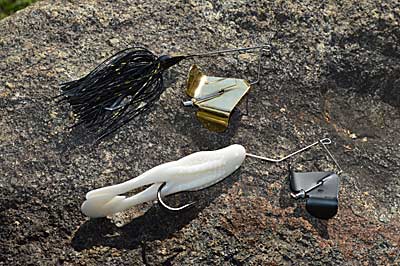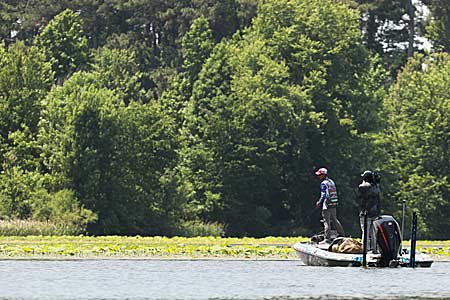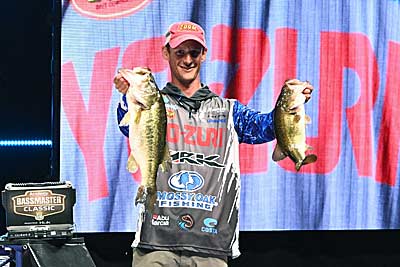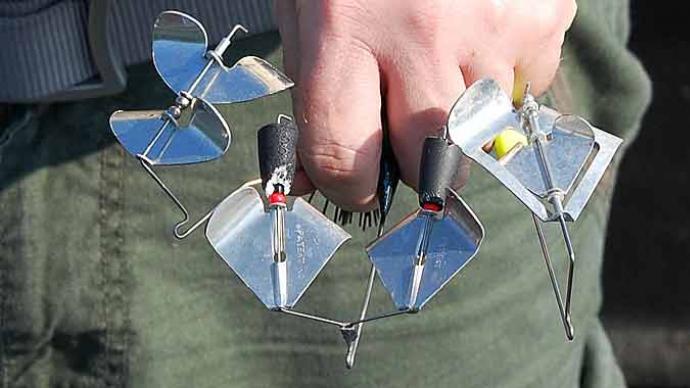
There are many reasons that specific lures fall from favor with anglers. For example, they may be too specialized for daily use or overshadowed by something new that claims to be better. But that doesn’t mean they stop producing.
Buzzbaits are in that category. Similar in shape to spinnerbaits, they sport a silicone skirt and at least one sizeable triangular paddle blade with opposing ears on two corners. Retrieve it along the surface, and it gurgles, churning up bass in the process. At one time, it was a popular summertime topwater with many anglers, though it seems hollow-bodied frogs and toads have now stolen its spotlight. But that’s not true for everyone.
Bassmaster Elite Series angler Brandon Cobb’s light for buzzbaits burns bright. The Palmetto State angler, who has qualified for the Bassmaster Classic three times and won two Elite events in his rookie season, is rarely more than an arm's length from a buzzbait when he's on the water. “I use them anytime the water temperature is right,” he said. “I keep [bass] honest and sling it around a bit. Some days they seem to want to bite it.”
Cobb said there are plenty of reasons for a bass to clobber a buzzbait. “It’s annoying,” he said. “I think it’s the noise. But it does look like a couple of shad fleeing. It's honestly like the Alabama rig concept." But instead of three to five swimbaits representing a school of baitfish, it uses a blade and skirt.
Catching the most and biggest bass on a buzzbait begins with choosing it over other lures. But it gets going when you understand what makes a great buzzbait and the best places and ways to fish it.
When To Fish A Buzzbait
The warm water of late spring through late summer invites many bass to shallow water. Of course, that's a perfect scenario for fishing buzzbaits. But don't pigeonhole them. They produce in a variety of situations, depths, and covers.
Cobb starts chucking buzzbaits as soon as the water temperature reaches 53 degrees. He admits that’s pushing things — they really hit their stride once the temperature reaches the mid-60s — but they’ll still trick some early-season bass. Cobb continues fishing them straight through fall when conditions — temperature and dissolved oxygen — force baitfish and bass shallow. Then, he only puts them up once the water temperature returns to the low 50s.
Baitfish and sometimes frogs are the common trait among the best buzzbait spots. Cover can vary. It could be backwater stumps or laydowns in spring, clumps or an edge of thick aquatic vegetation in summer, or riprap and docks in fall. And they’re tough to beat anytime in rivers, where the current pushes bass into predictable locations, especially shallow cover. But in lakes and reservoirs, depth isn’t critical. If bass are feeding at or just under the surface and there’s cover present, such as floating docks, then don’t hesitate to pick up a buzzbait.
Cobb believes the best thing about buzzbaits is their ability to cover water. That’s especially important when fishing the impoundments of the Southern United States. “The nature of these lakes is there’s not many bass in one place,” he said. “They can be everywhere, but there aren’t many in one place.”
Enter The Toad
For decades, most buzzbaits were similar to spinnerbaits. While you might occasionally come across an inline version, they were built on a wire safety-pin-style frame, paddle in place of blades, and the same living rubber or silicone skirt covering a large single hook. While those continue to catch bass, Cobb prefers a recent upgrade.

Cobb helped Georgia-based tackle manufacturer Greenfish design the Toad Toter. It represents a new breed of buzzbaits, which use a soft-plastic toad instead of a skirt. "I throw them most of the time because No. 1, you can reel them a little bit slower," he said. That comes from the toad’s wide and flat belly, which helps the lure plane across the surface. “It’s not always a good thing, but you can keep it in spots longer,” he said. Its design helps in other ways. “You can put it in places you can’t put a normal buzzbait,” he said. “You can skip it under docks or bushes. It's easier to present."
Several companies build buzzbaits specifically for use with a soft-plastic toad. And while they all catch bass, Cobb wants the confidence from knowing the one he’s throwing is perfect. The Toad Toter weighs 3/8 ounce, and its heavy wire frame, which features an R-bend for a line tie, adds durability. "The frame is light enough to make good noise, but it's not likely to break," he said. "And it's the appropriate weight. If you get too heavy, you can't reel it slow enough. And if you get too light, reel it at a decent speed, it will roll."
Toads, such as Zoom’s Horny Toad, are rigged over the Toad Toter’s small lead head and 4/0 black-nickel hook. But to get the most performance from it, or any buzzbait built for soft-plastic toads, the toad must be rigged perfectly straight. There’s no wiggle room. "I might run through a few toads to get one right," Cobb said. You want the hook to run through the lure's center, exiting between its legs, so the buzzbait tracks straight in the water. Time invested in getting it right pays off in more strikes.
Besides the toad’s kicking legs, these buzzbaits attract bass with the noise made by their blades. Greenfish offers a version of the Toad Toter that sports a clacker, which makes more noise than the standard one. Anglers can choose blade colors — white, black, gold, or nickel. Cobb selects nickel most of the time.
Like all soft-plastic lures, toads come in various color and flake combinations. Cobb likes to keep this choice plain, so he can concentrate on finding and catching bass. "I always lead with white," he said. "I don't have a strategy on why white vs. black. But if I have a couple miss [white], I change colors."
Rigging Up
The best buzzbait will help you catch more and bigger bass. Matching it to an appropriate rod, reel, and line makes it more powerful.
Start with a baitcasting rod at least 7 feet long, moderate-fast action, and heavy power. Its length will ensure long casts. It also will help get your buzzbait to the surface quickly: As soon as it touches down at the end of your cast, start reeling as you lift the rod's tip. And its heavy power will wrestle the biggest bass from the thickest cover.

Match your rod to a baitcasting reel with a high-capacity spool and sporty gear ratio. Long casts need plenty of line. And be sure to keep the spool topped off. Less line reduces circumference, slowing your retrieve. While crawling across the surface is usually the best speed for a buzzbait, a few quick reel turns with a 7:1 or 8:1 gear ratio will help your rod get it there faster. And as soon as it breaks the surface, you can slow your retrieve. That will maximize each cast.
Cobb is particular when it comes to choosing line for his buzzbait fishing. First, it has to be braid. “When you cast a buzzbait all day, it spins every cast,” he said. “So, your line gets twisted. Monofilament probably has a better hook-up ratio, but you'd have to change your line every four hours because it wraps around the tip.”
Line size depends on the amount of cover. For example, you'll want something stronger when buzzing around thick clumps of aquatic vegetation than if you're working down a riprap bank. But most times, 20- to 30-pound test braid will get the job done. Tie it directly to your buzzbait. There's no need to mess with a monofilament or fluorocarbon leader because your line is completely out of the water.
One thing that monofilament does better than braid is stretch. That bit of give creates a delay that increases the number of bass hooked. “We all want to pull when they strike,” Cobb said. It’s an exciting time, but you need to slow down. If the bass slashes at your buzzbait and misses, it’ll strike again if you don’t pull your lure away. “Take your time — reel until you feel them,” he said. “Don’t jerk based on what you see.”



